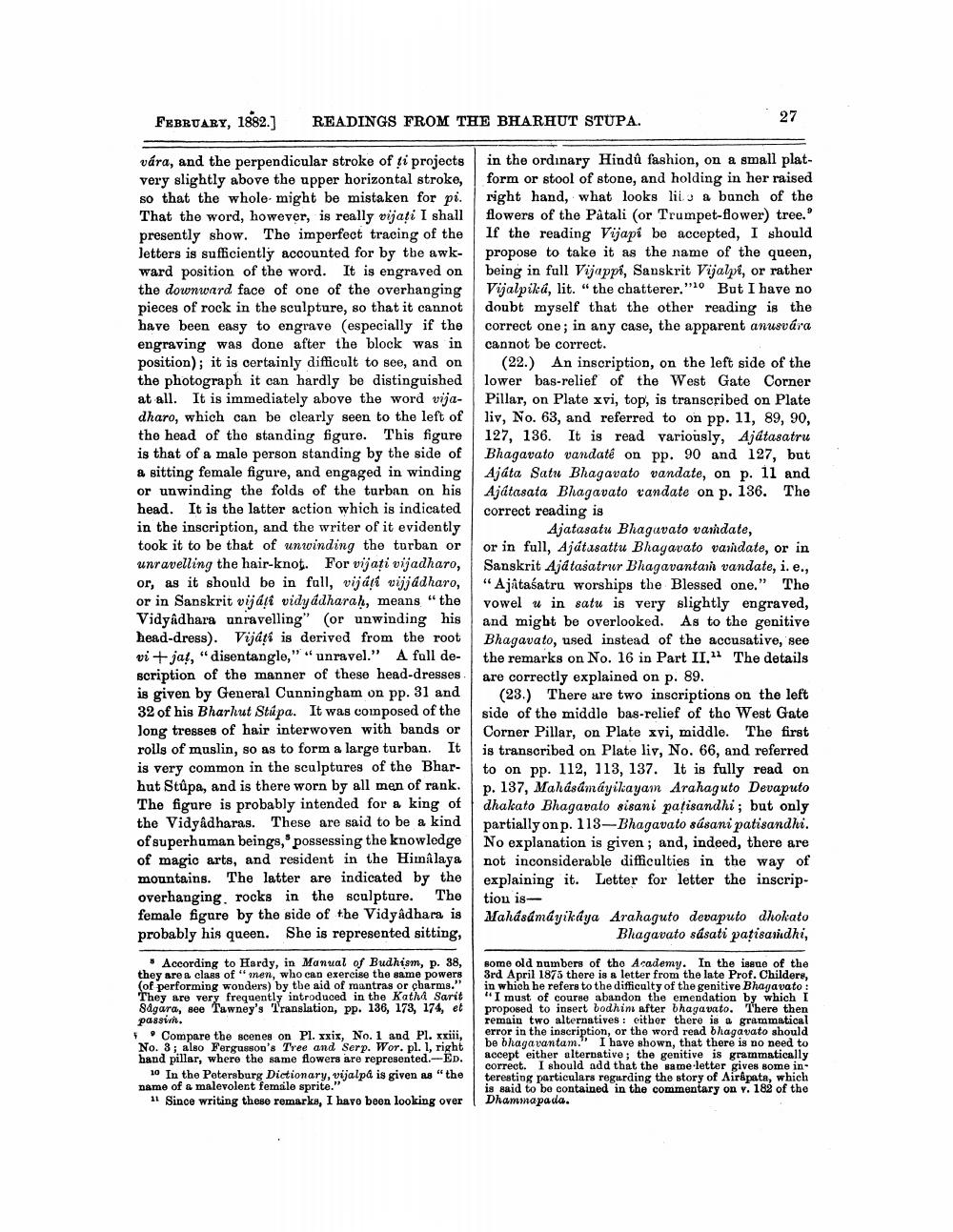________________
FEBRUARY, 1882.]
READINGS FROM THE BHARHUT STUPA.
27
vára, and the perpendicular stroke of ti projects in the ordinary Hindú fashion, on a small platvery slightly above the upper horizontal stroke, form or stool of stone, and holding in her raised so that the whole might be mistaken for pi. right hand, what looks like a bunch of the That the word, however, is really vijati I shall flowers of the Påtali (or Trumpet-flower) tree. presently show. The imperfect tracing of the If the reading Vijapi be accepted, I should letters is sufficiently accounted for by the awk- propose to take it as the name of the queen, ward position of the word. It is engraved on being in full Vijappi, Sanskrit Vijalpi, or rather the downward face of one of the overhanging Vijalpika, lit. "the chatterer." But I have no pieces of rock in the sculpture, so that it cannot doubt myself that the other reading is the have been easy to engrave (especially if the correct one; in any case, the apparent anusvára engraving was done after the block was in cannot be correct. position); it is certainly difficult to see, and on (22.) An inscription, on the left side of the the photograph it can hardly be distinguished lower bas-relief of the West Gate Corner at all. It is immediately above the word vija- Pillar, on Plate xvi, top, is transcribed on Plate dharo, which can be clearly seen to the left of liv, No. 63, and referred to on pp. 11, 89, 90, the head of the standing figure. This figure 127, 136. It is read variously, Ajatasatru is that of a male person standing by the side of Bhagavato vandaté on pp. 90 and 127, but a sitting female figure, and engaged in winding Ajáta Satu Bhagavato vandate, on p. 11 and or unwinding the folds of the turban on his Ajátasata Bhagavato tandate on p. 136. The head. It is the latter action which is indicated correct reading is in the inscription, and the writer of it evidently
Ajatasatu Bhagavato vandate, took it to be that of unwinding the turban or or in full, Ajátasattu Bhagavato varidate, or in unravelling the hair-knot. For vijati vijadharo, Sanskrit Ajdtasatrur Bhagavantain vandate, i.e., or, as it should be in fall, vijati vijjadharo, "Ajatasatru worships the Blessed one." The or in Sanskrit vijai vidyadharah, means "the vowel u in satu is very slightly engraved, Vidyadhara unravelling" (or unwinding his and might be overlooked. As to the genitive head-dress). Vijati is derived from the root Bhagavato, used instead of the accusative, see vi + ja, "disentangle," "unravel." A full de
the remarks on No. 16 in Part II." The details scription of the manner of these head-dresses
are correctly explained on p. 89. is given by General Cunningham on pp. 31 and (23.) There are two inscriptions on the left 32 of his Bharhut Stúpa. It was composed of the side of the middle bas-relief of the West Gate
g tresses of hair interwoven with bands or Corner Pillar, on Plate xvi, middle. The first rolls of muslin, so as to form a large turban. It is transcribed on Plate liv, No. 66, and referred is very common in the sculptures of the Bharto on pp. 112, 113, 137. It is fully read on hut Stúpa, and is there worn by all men of rank. p. 137, Mahásúmáyikayam Arahaguto Devaputo The figure is probably intended for a king of dhakato Bhagavato sisani pațisandhi; but only the Vidyadharas. These are said to be a kind partially on p. 113-Bhagavato súsani patisandhi. of superhuman beings,' possessing the knowledge No explanation is given; and, indeed, there are of magic arts, and resident in the Himalaya not inconsiderable difficulties in the way of mountains. The latter are indicated by the explaining it. Letter for letter the inscripoverhanging. rocks in the sculpture. The tion isfemale figure by the side of the Vidyadhara is Mahásámáyikāya Arahaguto devaputo dhokato probably his queen. She is represented sitting,
Bhagavato sasati Patisa vidhi,
. According to Hardy, in Manual of Budhism, p. 38, they are a class of " men, who can exercise the same powers (of performing wonders) by the aid of mantras or charms." They are very frequently introduced in the Katha Sarit sagara, see Tawney's Translation, pp. 136, 173, 174, et passin.
Compare the scenes on Pl. xxix, No.1 and Pl. xxiii, No. 3; also Fergusson's Tree and Serp. Wor. pl. 1, right hand pillar, where the same flowers are represented.-ED.
10 In the Petersburg Dictionary, vijalp is given as "the name of a malevolent female sprite."
11 Since writing those remarks, I havo been looking over
some old numbers of the Academy. In the issue of the 3rd April 1875 there is a letter from the late Prof. Childere, in which he refers to the difficulty of the genitive Bhagavato: "I must of course abandon the emendation by which I proposed to insert bodhin after bhagavato. There then remain two alternatives: either there is a grammatical error in the inscription, or the word read bhagavato should be bhagavantam." I have shown that there is no need to accept either alternative; the genitive is grammatically correct. I should add that the same letter gives some in teresting particulars regarding the story of Airfpats, which is said to be contained in the commentary on v. 182 of tho Dhammapada.




